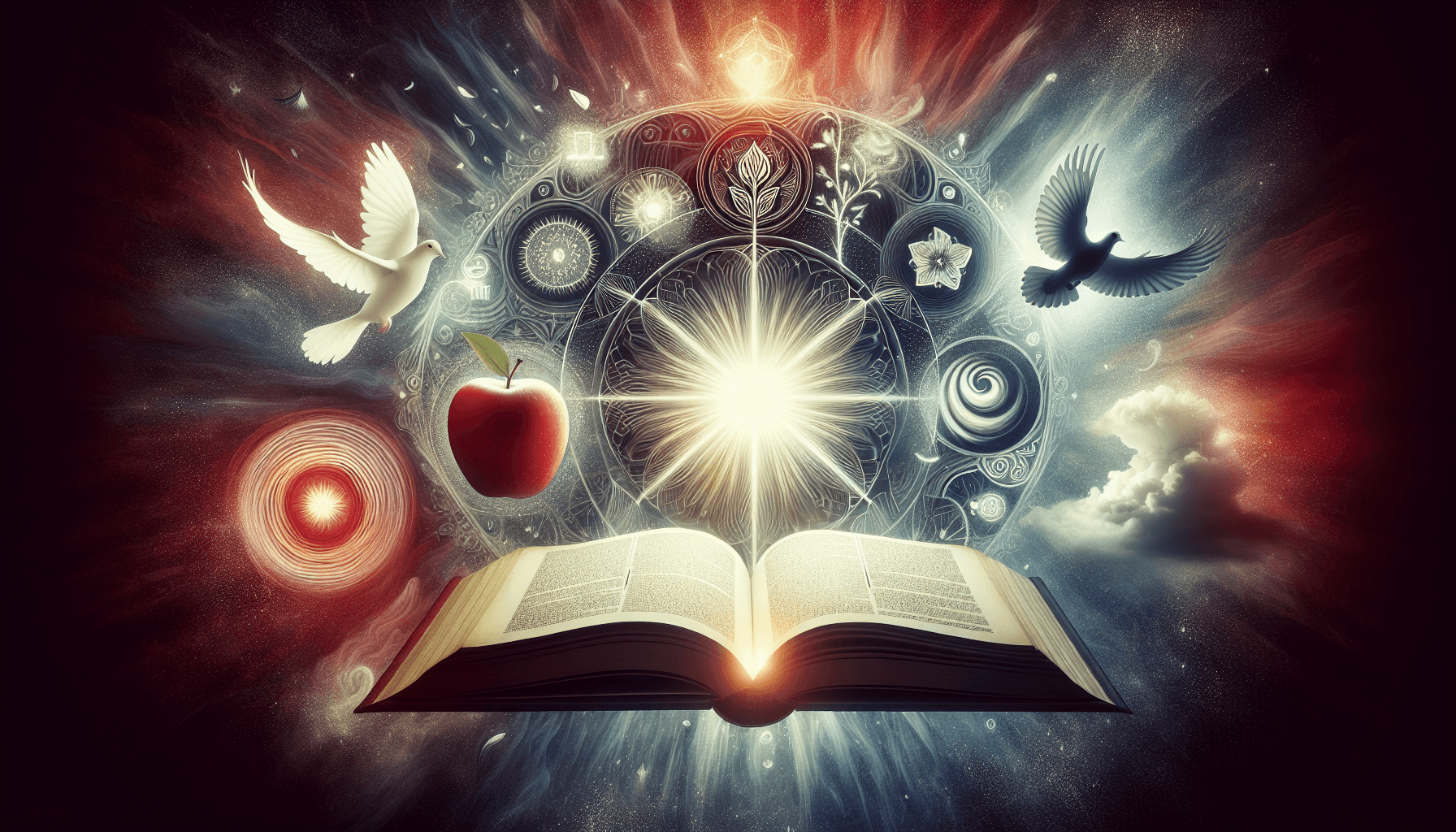Table of Contents
We all know that literature can be a bit like a treasure hunt, right? Sometimes, those hidden meanings can leave us scratching our heads. It’s totally normal to feel lost when it comes to understanding symbolism. After all, what’s with all those apples, doves, or even raging storms?
But don’t worry! If you stick around, I promise you’ll uncover the secrets behind these symbols and how they add depth to stories. By the end, you’ll be spotting them like a pro, turning confusion into clarity!
We’ll explore different types of symbolism, break down common symbols, and see how they shape themes and characters. Plus, we’ll dive into how symbolism varies across cultures and formats, making your reading experience richer and a lot more fun!
Key Takeaways
- Symbolism is a vital tool in literature that deepens stories and connects complex ideas without direct explanation.
- Recognizing different types of symbolism—universal, cultural, and personal—can enhance your reading experience.
- Common symbols like owls for wisdom or storms for change appear across literary works; recognizing them adds meaning.
- Symbols play a critical role in shaping themes and character development, revealing motivations and underlying messages.
- Engaging with symbolism transforms reading into an interactive experience, fostering personal connections and discussions.
- Cultural contexts affect the interpretation of symbols, enriching literature from diverse backgrounds.
- The way symbolism is used differs in poetry and prose, affecting emotional impact and narrative delivery.

Understanding the Importance of Symbolism in Literature
Symbolism is a powerful tool that authors use to add depth and richness to their stories.
By incorporating symbols, writers can convey complex ideas and emotions without explicitly stating them, allowing for a layered narrative.
This enhances the reading experience, prompting readers to engage more critically with the text.
For example, a rose might symbolize love, but its color could add another layer—red for passion, white for purity.
When readers pick up on these subtleties, it can lead to deeper conversations about the themes and characters within the story.
Essentially, symbolism not only enriches the narrative but also invites readers to think critically and draw personal connections to the text.
Recognizing Different Types of Symbolism
Not all symbols are created equal, and understanding the different types can enhance your reading or writing experience.
There’s *universal symbolism,* which carries the same meaning across different cultures, like the heart representing love.
Then we have *cultural symbols,* which may hold specific meanings within particular societies, such as the eagle as a symbol of freedom in the United States.
*Personal symbolism* comes into play when authors use objects unique to their experiences, adding layers for those who know the backstory.
To recognize these symbols, pay attention to recurring images or motifs throughout the text.
Make a note of them and consider their implications on characters and plot development.
Identifying Common Symbols in Literature
Many symbols appear across various literary works, and familiarizing yourself with them can enhance your understanding of stories.
Examples include the *owl,* often representing wisdom, or the *storm,* symbolizing turmoil or change.
Common colors also play significant roles: *black* can signify death or mystery, while *white* often connotes innocence.
Start identifying these symbols by watching for them in the literature you read; consider what they might mean within the specific context.
Try keeping a journal of symbols you encounter, along with their meanings and the feelings they evoke.
This practice can enrich your reading experience, making it more engaging and thought-provoking.

Analyzing the Impact of Symbolism on Themes
Symbolism can significantly influence the themes of a literary work.
When an author employs symbols, they often enhance the central themes, making them more profound and relatable.
For instance, in George Orwell’s “Animal Farm,” the farm itself represents various political ideologies, allowing readers to grasp complex themes of power and corruption easily.
To analyze the impact of symbolism, consider what each symbol reveals about the theme.
Jot down observations on how symbols interact with the narrative and how they elevate the story’s underlying messages.
This will help uncover the author’s intentions and make the reading experience more enriching.
Exploring Symbolism in Character Development
Symbolism often plays a crucial role in character development, offering deeper insights into the characters’ motivations.
When authors introduce symbols tied to characters, it can signify growth, struggle, or change.
For example, in *The Great Gatsby,* the green light symbolizes Gatsby’s hope and dreams for the future, reflecting his character’s aspirations and ultimate tragedy.
To explore symbolism in character development, pay attention to how objects or themes correlate to specific character arcs.
This can be a telltale sign of conflict and transformation, making it easier to understand the storyline’s emotional weight.
Examining How Symbolism Enhances the Reader’s Experience
Symbolism enriches the reader’s experience by inviting them to engage actively with the text.
When readers encounter symbols, they often pause to decode their meanings, creating a more immersive experience.
This engagement fosters personal connections to the narrative, allowing different interpretations based on individual perspectives.
To enhance your reading experience, challenge yourself to identify symbols as you read.
Ask questions like: What does this symbol represent? How does it affect the plot or characters?
These reflections can transform a straightforward read into a thought-provoking journey.
Applying Symbolism to Modern Literature
Many contemporary authors leverage symbolism, making it essential to recognize its presence in modern literature.
Books like *The Night Circus* by Erin Morgenstern use vivid, enchanting symbols (like the circus itself) to frame themes of love and competition.
When reading modern literature, consider how symbols reflect current societal issues or personal struggles.
Ask yourself how these symbols add layers to characters or themes.
This practice can deepen your appreciation for the author’s craft and prompt engaging discussions with fellow readers.
Discussing Symbolism Across Different Cultures
Symbolism varies significantly across cultures, enriching global literature.
Understanding cultural contexts can expand your interpretation of symbols in texts from different backgrounds.
For example, the lotus flower symbolizes purity and enlightenment in many Asian cultures, often found in literary works exploring these themes.
To grasp the nuances of symbolism in cross-cultural contexts, do a bit of research on specific symbols before reading.
This preparation can help decode a story’s deeper meanings, making your reading experience even more rewarding.
Evaluating Symbolism in Poetry vs. Prose
Symbolism can manifest differently in poetry compared to prose, and recognizing these differences enhances literary analysis.
In poetry, symbols often emerge through vivid imagery and concise language, creating strong emotional resonance.
Conversely, prose may develop symbols over longer narratives, allowing for a more gradual reveal of significance.
To evaluate symbolism effectively, consider the pacing and delivery of symbols in each format.
This awareness can help you appreciate the different ways authors convey meaning and emotion in their work.
FAQs
Symbolism enhances literary works by adding deeper meanings and connecting themes. It allows readers to interpret and understand the underlying messages, emotions, and cultural references that enrich the narrative.
To identify common symbols, observe recurring objects, colors, or motifs throughout the text. Consider their context and the emotions they evoke, as they often suggest deeper meanings related to the themes or characters.
Symbolism significantly contributes to character development by illustrating their complexities and motivations. Characters may embody specific symbols that reflect their journeys or personal conflicts, enhancing their depth and relatability.
In poetry, symbolism often relies on concise imagery and emotional resonance, while prose may elaborate on symbols with more detail and narrative context. Both forms use symbolism to convey complex ideas, but the methods vary.



